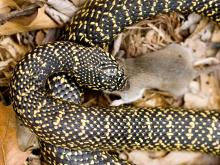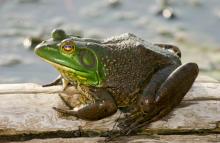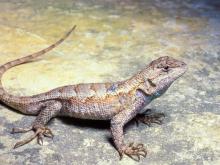Reptiles and Amphibians
Media

Species Types
Scientific Name
Coluber constrictor flaviventris (eastern yellow-bellied racer) and Coluber constrictor priapus (southern black racer)
Description
The eastern yellow-bellied racer is uniformly tan, brown, olive, blue, gray, or nearly black on top, with a yellow, cream, or light blue-gray belly. It occurs nearly statewide. The southern black racer subspecies also lives in the southeastern half of the state.
Media

Species Types
Scientific Name
Thamnophis proximus proximus
Description
The orange-striped ribbonsnake is a type of gartersnake named for the attractive orange or yellow stripes running the length of its body, alternating with wide black stripes. It is found statewide, but seldom far from water.
Media

Species Types
Scientific Name
Lampropeltis holbrooki
Description
The speckled kingsnake is generally black, but a white or yellow spot in the center of most of the scales makes it look speckled. The belly is yellowish with some irregular black markings. A harmless, beneficial snake found nearly statewide.
Media

Species Types
Scientific Name
Terrapene carolina triunguis
Description
The three-toed box turtle usually has three hind toes. Its high-domed shell usually has a top ridge and is olive or brown with faint yellow or orange lines. Look for it in woodland habitats.
Media

Species Types
Scientific Name
Chrysemys picta bellii
Description
The western painted turtle is a small, brightly colored aquatic turtle. The upper shell is smooth and has a red-orange outer edge. The colorful lower shell has a prominent pattern of brown markings. It is found nearly everywhere in the state except the southeast region.
Media

Species Types
Scientific Name
Kinosternon subrubrum hippocrepis
Description
Although well equipped for an aquatic existence, the Mississippi mud turtle spends as much time wandering about on land as it does in water. Look for it in the Mississippi Lowlands of Missouri’s Bootheel.
Media

Species Types
Scientific Name
Lithobates catesbeianus (formerly Rana catesbeiana)
Description
The American bullfrog is Missouri’s largest frog. This common species is easy to hear on warm nights when the males call a deep, sonorous “jug-a-rum, jug-a-rum” that can be heard from half a mile away.
Media

Species Types
Scientific Name
Sceloporus consobrinus
Description
The prairie lizard is a small, gray to brown, rough-scaled lizard common in open forests. It often lives around country homes and rock gardens and on stacks of firewood and split rail fences.
Media

Species Types
Scientific Name
Thamnophis sirtalis sirtalis (eastern gartersnake) and T. s. parietalis (red-sided gartersnake)
Description
The eastern gartersnake and red-sided gartersnake are Missouri's most common gartersnakes. The color is variable, but there are normally three yellowish stripes, one down the back and one on each side. There are narrow black bars between the scales along the upper lip.
Media
Species Types
Scientific Name
Ophisaurus attenuatus attenuatus
Description
The western slender glass lizard is often called “glass snake” because it is long, slender, and legless, and its tail breaks off easily. But glass lizards are true lizards, with eyelids and ear openings; snakes have neither of these characteristics.
See Also
About Reptiles and Amphibians in Missouri
Missouri’s herptiles comprise 43 amphibians and 75 reptiles. Amphibians, including salamanders, toads, and frogs, are vertebrate animals that spend at least part of their life cycle in water. They usually have moist skin, lack scales or claws, and are ectothermal (cold-blooded), so they do not produce their own body heat the way birds and mammals do. Reptiles, including turtles, lizards, and snakes, are also vertebrates, and most are ectothermal, but unlike amphibians, reptiles have dry skin with scales, the ones with legs have claws, and they do not have to live part of their lives in water.





















